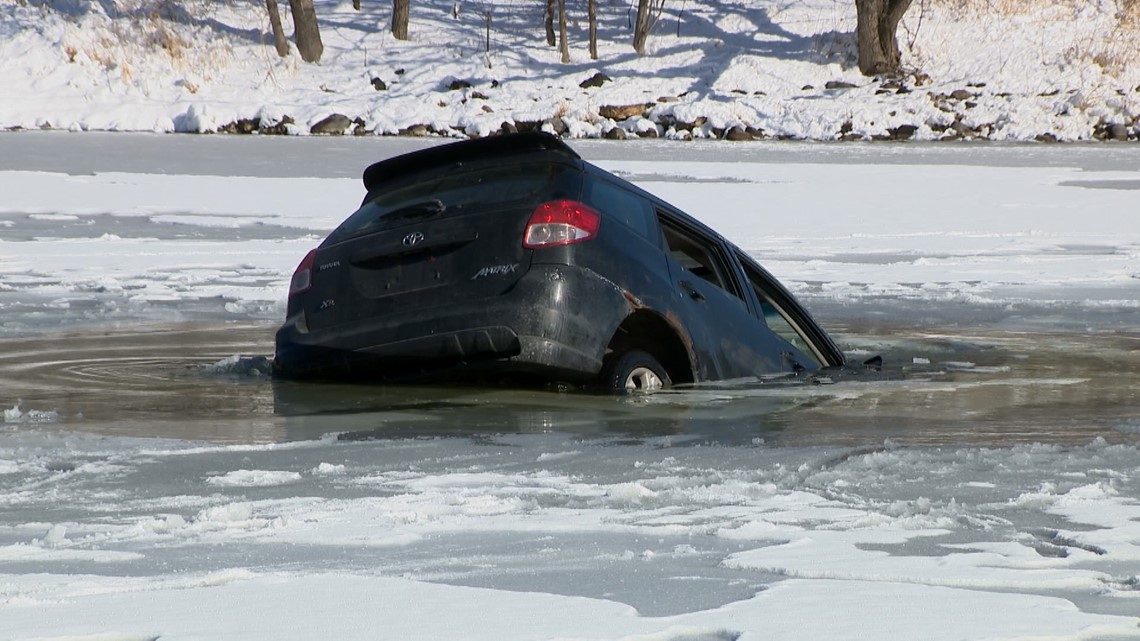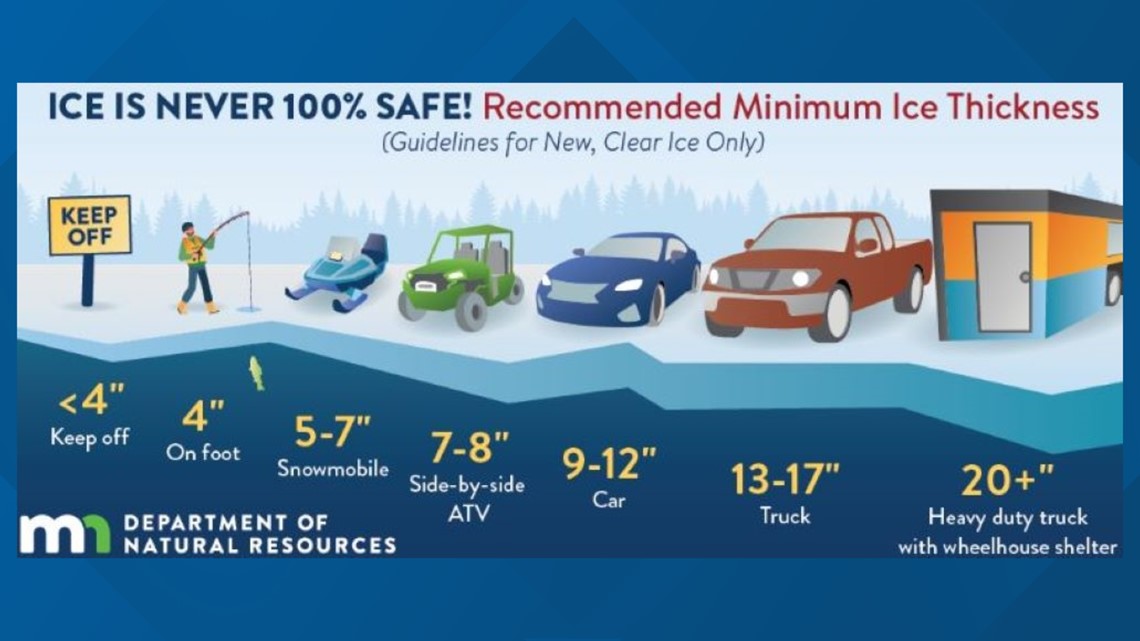Kare11
Car through the ice, here’s how to survive

It’s been a weird winter and the ice is even more unpredictable. We teamed up with the DNR to sink a car in a lake to show you how to escape.
MAPLEWOOD, Minn. — The number of people who died falling through the ice on Minnesota lakes so far this year is on track to be double what it was all of last year. So, we thought it was a great time to talk about ice safety.
A couple of years ago, we teamed up with the Minnesota Department of Natural Resources (DNR) to have someone fall through the ice, to teach us how to get out.
This year we decided to do something different — we sunk a car in a lake.
Using GoPros, a drone and a diver, we teamed up again with the Minnesota DNR — and the Ramsey County Sheriff’s Department — to show you exactly what happens if you break through, what you can do to survive and something to keep in mind with electric vehicles.
We were out on Spoon Lake in Ramsey County for the drill. The car didn’t break through the ice as quickly as we thought, considering the conditions, so they drilled holes to make the process go faster.
First, the front wheels went through.
“Usually, you’re going to have about a minute or so to get out, so it’s not like it just instantly sinks to the bottom,” said Arnaud Kpachavi, with the Minnesota DNR.
From the time the front wheels broke through the ice to the time the cabin filled up with water was 1 minute, 41 seconds.
“What we saw here, where it gets hung up on an ice shelf for a little bit first, is typically what I’ve seen when I’ve responded to these,” Kpachavi explained.
It took just under 4 minutes for the entire car to slide under the ice.
Keep in mind this is a small car, with no battery or fluids or people or fishing gear. The heavier the car or truck, the faster it will sink. And electric vehicles are even heavier than their gas-powered counterparts — up to 30% heavier because of their battery packs.
BELOW: Back in 2019, the Minnesota DNR showed us what to do if you fall through the ice.
“The doors, a lot of times it won’t open, like you can see out there the driver’s side door is tight up against the ice. So my guess is if there was someone inside that car right now, they wouldn’t be able to open the door,” said Kpachavi. “Even if there is no ice right next to the door blocking it, a lot of times the water pressure rushing in will be too much to push the door open, even without a obstruction.”
So his advice? Always have the windows down before you drive on the ice. It’s your best chance of escaping.
“If you are in a vehicle and it’s completely submerged, don’t just think it’s over and give up,” he said. “You’ve got as much time as you’ve got breath to get up.”
And Arnaud is experienced at this, he has had to practice this in training.
“Just the big thing there, is remembering which way is up as you are going down, because if you’re in a situation where your car flips over, you just want to remember when you come out the window, obviously toward the roof is going to be down at that point,” he added.
But let’s go back to the beginning, before you’re in this predicament. Besides rolling down the windows, there are other things you can do before you get out there.
The first seems like a no-brainer, but check the ice thickness, even if you see someone else already on the lake.


Wear ice picks around your neck, but keep floatation devices, like life jackets, on the seat next to you.
“You don’t actually want to be wearing them when you are in the vehicle, because if the vehicle goes down, and you are stuck inside, it can actually make it tough to be able to swim out of a window,” Kpachavi said of the life jackets.
Have a plan with the people in the car, especially if there are kids with you or people not used to going out on a frozen lake. And keep your cell phone in your pocket.
“Getting that 911 call out right away is super important because you’re going to be wet, cold, a lot of times a little panicked from what just happened,” he said.
Decide whether or not you’re going to wear a seatbelt. While they can protect you from other drivers on the lake, it’s one more thing holding you down when you’re trying to get out. And if you are belted in, keep a seatbelt cutter on your visor. It can also be used to break windows if necessary.
OK, now you’re out and safe, but it’s not over yet. You legally have 48 hours to notify the sheriff’s department what happened. And for good reason.
“Because if we don’t know that, we’ll have to assume someone is down in that vehicle, and that’s going to generate a huge law enforcement and public safety response,” Kpachavi said.
You also have 30 days to get the car out of the drink on your own dime. That’s to make sure the fluids don’t leak out into our lakes. It’s an environmental concern. And if you don’t, you could face fines up to five times what it costs the sheriff’s department to do it.
So, now you’re prepared — at least as prepared as you can be for the unpredictable.
Here’s a list of all the tips to keep you safe on the ice:
- Check the ice thickness. (DNR Ice Thickness Chart)
- Open your windows.
- Put flotation devices on seat next to you.
- Keep your cell phone in your pocket.
- Keep a seatbelt cutter on your visor.
- Try to get out quickly before the car sinks.
- If you are under water, remember which way is up or follow the direction of the bubbles.
- When you are out, call for help.
Kare11
Remains of Korean War solider from Minneapolis to buried


The U.S. Army says 19-year-old William E. Colby was reported missing in action on Dec. 2, 1950. His remains were identified just this year using DNA technology.
MINNEAPOLIS — A young soldier from Minneapolis will finally be at rest, 74 years after his death while serving in Korea.
The U.S. Army says William E. Colby of Minneapolis will be interred at Fort Snelling National Cemetery on Dec. 3, seven months after his remains were identified using DNA technology.
Colby was just 19 years old and serving in the Korean War when he was declared missing in action on Dec. 2, 1950, after his unit was attacked by the Chinese People’s Army as they attempted to withdraw from the Chosin Reservoir. The young solider could not be recovered following the battle, and the U.S. Army issued a presumptive finding of death on Dec. 31, 1953.
His fate was finally confirmed for family members by the Defense POW/MIA Accounting Agency on May 2, 2024, after Colby’s remains were identified from 55 boxes of remains returned to the U.S. by the North Korean government in 2018.
The Army Casualty and Mortuary Affairs Operations Division at Fort Knox, Ky., plays a key role in finding family members to identify missing Soldiers from WWII, the Korean and Vietnam Wars. The process begins with obtaining a DNA sample from the living person identified as next of kin and then using several forms of DNA analysis to match remains.
Survivors then receive access to the soldier’s military benefits and a burial with full military honors.
Kare11
Old National to partner with St. Paul-based Bremer Bank


This merger will include 70 banking centers across Minnesota, North Dakota and Wisconsin.
SAINT PAUL, Minn. — St. Paul-based Bremer Financial Corporation and Old National Bancorp announced a merger Monday.
After the merger is completed, Old National will become the third-largest bank in the Twin Cities, according to the press release. The smaller Bremer Bank had $16.2 billion in total assets, $11.5 billion in total loans and $13.2 billion in deposits as of Sept. 30.
“For more than 80 years, we’ve been honored to carry out the legacy of our founder, Otto Bremer,” Jeanne Crain, President and CEO of Bremer, said in a press release. “When our majority shareholder, the Otto Bremer Trust, reaffirmed its interest in selling Bremer Bank, we appreciated the opportunity to identify a partner through a collaborative process to ensure the best possible outcome for our customers, employees, and our communities. With Old National, we have confidence we found a great fit.”
The partnership includes 70 total banking centers in Minnesota, North Dakota and Wisconsin. The merger is expected to be finalized in mid-2025.
For shareholders, each share of Bremer common stock will be converted into the right to receive 4.182 shares of Old National common stock plus $26.22 in cash, which equals about $116.76 per share, based on Old National’s estimate in the press release.
Kare11
What Thanksgiving foods can you share with your pet?


As tempting as it is to slide unwanted foods to your dog or cat, check this list before doing so.
GOLDEN VALLEY, Minn. — Do you share a bite of your meals with your beloved pet?
Whether you hand your dog a piece of meat while you’re cooking or let your cat slurp some milk, it is all too common for pet owners to share with their furry friends. But during the holiday season, it is extra important to check what foods are healthy and possibly toxic before you share.
The Animal Humane Society shared a list of what common holiday foods your pet can and cannot eat.
Toxic:
- Raw or undercooked meat, eggs and bones: this can put your pet at risk of Salmonella and E. coli. Bones can splinter and become lodged in or puncture your pet’s digestive tract
- Desserts: chocolate is poisonous for both cats and dogs. Also, xylitol, a common artificial sweetener, can lead to liver failure
- Garlic, onions and chives: irritate stomachs in small amounts, toxic in large amounts
- Grapes and raisins: can cause kidney damage
- Nuts: can cause vomiting, diarrhea and pancreatitis
- Salty snacks: cause excessive thirst and sodium poisoning
- Citrus fruits: citric acid can cause minor stomach upset in small doses, and can act as a central nervous system depression if eaten in large amounts
- Milk: most cats are lactose intolerant and eating dairy can lead to diarrhea and vomiting. Dogs can have small amounts of milk, but some dogs are also lactose intolerant
For more foods to avoid feeding your pet, check the website of the American Society for the Prevention of Cruelty to Animals (ASPCA). If you think your pet has eaten something poisonous, call the Pet Poison Helpline at 855-764-7661.
Foods you CAN give your pet:
- Eggs: This can be a healthy treat for your dog or cat as eggs are full of amino acids and protein. Just make sure to fully cook the eggs
- Fish: Most fish can be beneficial for your pet as long as it is fully cooked with the bones removed
- Meat: Purina reports that cooked, lean meats such as beef, chicken, turkey, liver and lamb are okay for your pet to eat. Make sure you cook the meat thoroughly and remove all skin and bones
For more on foods you can bond over with your pet, check out the American Kennel Club or Purina.



